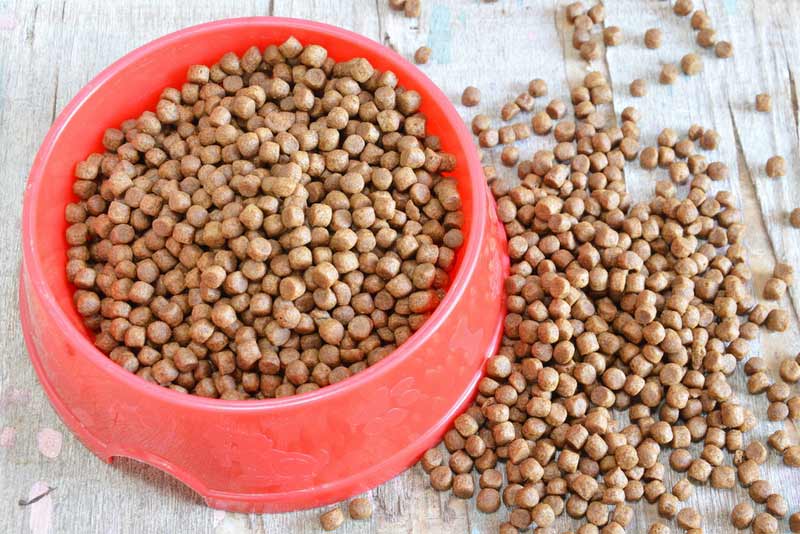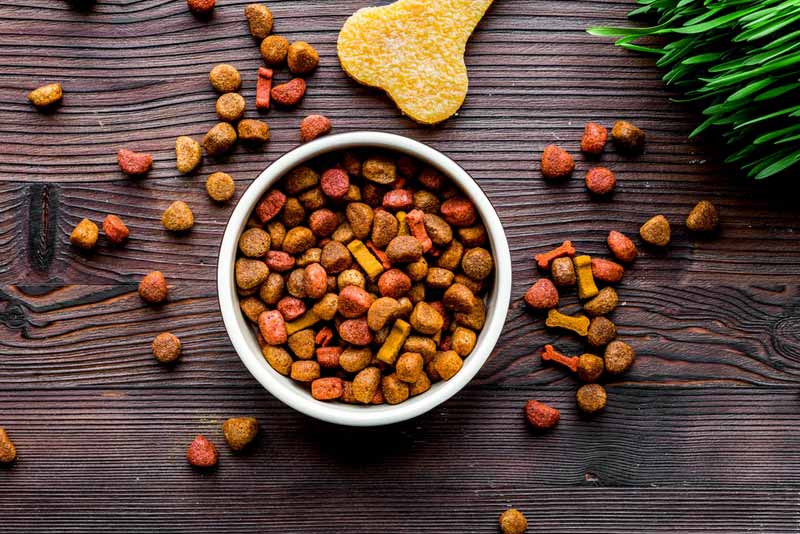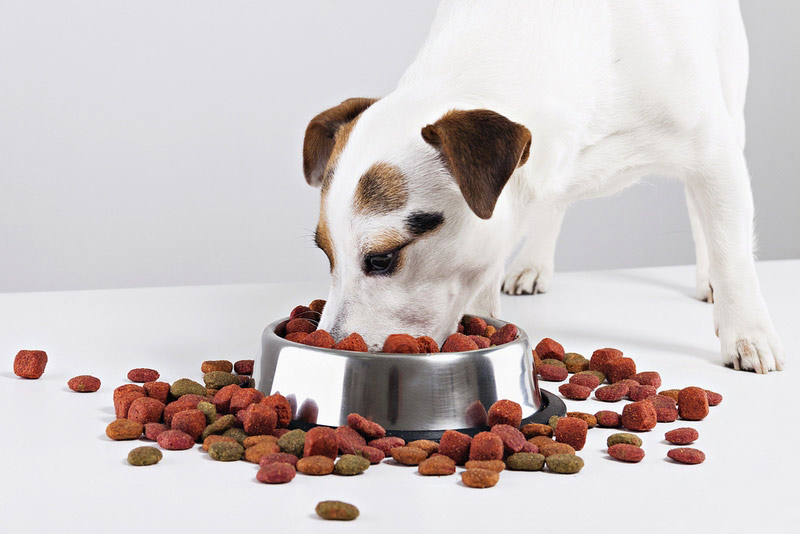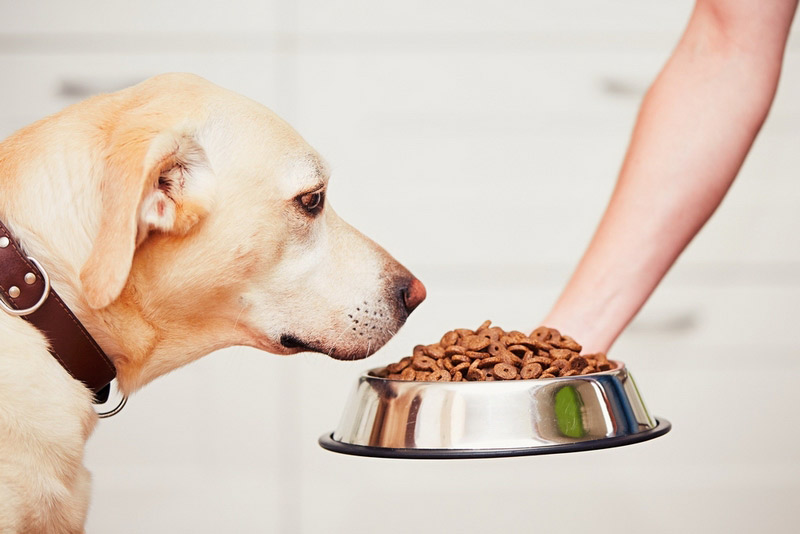
As a dog owner, it’s easy to assume that the biggest dog food brands out there have your pooch’s best interests at heart.
Unfortunately, many dog food companies are adding a host of chemicals, preservatives, and other dangerous items to your dog food that can cause major harm to your pet.
Read on to discover these ingredients and how you can find a dog food that actually keeps your dog healthy.
12 Toxic Ingredients to Avoid in Dog Food
1. Butylated Hydroxyanisole (BHA)
BHA is a synthetic antioxidant added to pet and other preserved foods in order to prevent fats from turning rancid. While this sounds like a good thing at first glance, it turns out this synthetic has been shown to cause cancer and promote its growth in rat stomachs, and has also been listed as a carcinogen (even to humans) on California’s Prop 65 list. (1, 2)
2. Butylated Hydroxytoluene (BHT)

BHT is very similar to BHA, and is added to packaged foods for the same reasons: to prevent fats from becoming rancid. Unfortunately, this version is no better than its cousin, having been found to act as an endocrine disruptor and carcinogen in animals. One study found BHT increased incidence of pulmonary and pituitary tumors in mice, even at a low dosage. (3, 4)
3. Ethoxyquin (“Fish Meal”)
Ethoxyquin (also sometimes listed as “fish meal”) is yet another chemical preservative used to prevent fats in pet food from going rancid. The effects of ethoxyquin are so detrimental that it has been banned in the European Union; however, the U.S. still uses it. Side effects include: hemorrhage, liver damage, cancer, kidney damage, and thyroid damage. (5)
4. Propylene Glycol
Propylene glycol, an ingredient also found in antifreeze, is a colorless chemical found in processed foods as well as cosmetic products. Studies have shown it can cause skin irritation, kidney damage, and negative effects on the liver. (6, 7)
5. Food Dyes

Food dyes, like Red Dye 40, are chemical colorings added to dog food. They have no nutritional value, and have in fact been shown to increase hyperactivity, impulsiveness, and inattention (common ADHD symptoms in humans). (8) If your dog is having behavior problems, you might want to take a look and see if any of these colorings are in his or her current food brand.
In addition, several food dyes are confirmed carcinogens. (9)
6. Rendered Fat
Rendered fat is fat obtained from (usually) some type of animal fat. The problem with rendered fat is that it’s nearly impossible to tell where it came from. And unfortunately, in the majority of cases, this fat comes from leftover meat byproducts (aka scraps from slaughtered animals) that can be contaminated with plastics, antibiotics, and all manner of nasties – even traces of sodium pentobarbital, the drug used to euthanize animals. (10)
7. Wheat Gluten
For the same reasons Paleo dieters avoid wheat and gluten, your pet should as well. Not only is the majority of wheat produced in the U.S. genetically modified, but has also been shown to cause gut inflammation and an immune response, as well as autoimmune thyroid disorders. (11, 12) Furthermore, dogs are carnivores, meaning they have no need for grains of any type in their diets.
8. Meat Byproducts

Meat byproducts are the organs and other tissues obtained from dead animals that aren’t used for human consumption. While dogs are meat eaters and would indulge in organ meats in their native habitats, the problem with meat byproducts lies in their sourcing. Some companies use byproducts from reputable, clean sources. However, it’s usually extremely difficult to identify these, as the terms are vague.
Most byproducts come from roadkill, dead zoo animals, diseased or dying livestock, and even euthanized pets from animal shelters. These can contain harmful pathogens, chemicals, and even traces of euthanasia drugs. (13)
9. Carrageenan
Carrageenan is a common thickener, stabilizer, and texturizer found in many processed food products. Studies have shown it causes intestinal ulcerations, gastrointestinal inflammation, and even cancer in humans and animal studies. (14)
10. Corn and Soy
Corn and soy are popular main ingredients in dog food, mostly used to thicken the product and cut costs. Unfortunately, the problems with corn and soy are plentiful. To begin, the majority produced in the U.S. is genetically modified and has been sprayed with potentially cancer-causing chemicals like Monsanto’s RoundUp. (15) The chemical used in RoundUp, glyphosate, has been banned in several other countries over concern of the links to cancer and kidney disease, and has additionally been linked to a higher rate of non-Hodgkin lymphoma in farmers in the Midwest. (16)
Corn and soy are also far from the carnivorous diet natural to canines, making it incompatible with their species.
11. Sorbitol

Sorbitol is a sugar alcohol extracted from corn that is sometimes added to pet foods and is used as a sugar substitute in human foods. Unfortunately, it has a strong laxative effect and has been found to raise blood sugar in dogs, which could lead to hyperactivity or behavior issues. (17)
12. Xylitol
Xylitol is another sugar alcohol that should never be fed to your dog. Studies have found that it not only causes hypoglycemia in dogs, but also acute, life-threatening liver disease. (18) Since xylitol is present in so many human desserts, avoid feeding your dog any of these as well.
How to Choose Healthy Dog Food
Now that you’re aware of the hidden dangers in most commercial dog foods, let’s take a look at how you can choose a healthier brand for your pooch.
Look for minimal, quality ingredients.

The ingredient list on your pet food should look similar to the ingredient list on something you would eat. For instance, it should contain whole food ingredients like turkey, sweet potato, berries, chicken, carrots, etc., and be free of any lengthy chemical names aside from fortified nutrient ingredients, like vitamin C or B vitamins.
Also, when you’re looking for meat ingredients on the label, make sure the meat sources are named, such as “turkey,” “chicken,” or “beef.” Avoid terms like “meat,” “poultry,” and “animal.” This ensures there are no byproducts or strange ingredients hiding under obscure labels.
Avoid grains.

Dogs are carnivores, meaning they have no nutritional requirement for grains. Processed grains are added to most dog food brands for the same reasons they are added to products for human consumption: to lower production costs.
The reason grains are unhealthy for dogs is similar to why they aren’t ideal for humans: grains contain anti-nutrients (lectins and phytates) that can irritate their gut lining and cause all sorts of digestive issues, as well as increase chronic inflammation. (19)
Look for natural preservatives, like vitamin C and vitamin E. Also called “tocopherols,” these vitamins act as natural preservatives in food, ensuring you’re avoiding preservatives like BHA and BHT.
You can also avoid preservatives of any kind altogether by purchasing brands that only use real, whole foods as their ingredients. These types of brands will typically require you to keep the food frozen until ready to serve.
Look for natural food colorings, like beet juice.
In general, the best dog food won’t have any need for food dyes or colorings. If you see any color names (e.g., Red Dye 40) followed by numbers or letters, skip that particular brand, as they’re using artificial food colorings. Instead, look for no colorings or natural food colorings from beet juice or annatto.
Research brands before you buy: reputable brands will have transparent information on their websites.
The best brands of dog food are usually the most transparent: they want you to know what ingredients are in their food, how it’s made, and why it’s better than the rest. Because of this, these brands will have every quality ingredient they use listed on their website. If you’re in doubt or can’t find the information, contact them directly.
Some suggestions:
- Just Food For Dogs: Prepares and delivers human-grade, whole food meals for your dog. They are available in select stores and online.
- Darwin’s Natural Pet Products: Raw, grain-free, free-range meats and vegetables.
- Merrick: Grain-free, raw, freeze-dried meats and vegetables focused on ancestral canine nutrition.
- Blue Wilderness: Grain-free meat, vegetable and fruit-dried kibble with added antioxidants and minerals.
Check for a nutritional adequacy statement from AAFCO (the Association of American Feed Control Officials).
AAFCO insures the blend meets minimal nutritional requirements.
The Bottom Line
Why companies add these toxic ingredients to pet food in the first place is simple: to cut costs. It might seem outrageous and unethical (and most would agree), but it is the reality we and our pets live in. The simplest solution to help solve this problem is to protest with our pocketbooks. Purchasing healthy, nourishing dog food from caring brands will help drive out these nefarious practices and reduce the demand for the type of chemicals and additives listed here.

